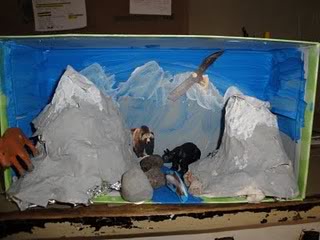Dioramas
Some of the NaturExplorers guides suggest the completion of a diorama to go along with a research project. Dioramas are such a fun and creative way to model entire habitats or ecosystems. Even better, they can prove to be an informal assessment of your child’s understanding when you ask him or her to create a diorama including all parts of a particular habitat/ecosystem – food, water, shelter, and even predators.
Alicia from La Famille and her children spent some time studying landforms this past school year and created a diorama of each topic they covered. We found their dioramas to be excellent examples of how to prepare a complete and visually pleasing diorama. You’ll notice each of the dioramas include:
- Full use of the space in the box
- Realistic landforms
- Entire habitats – food, water, shelter, and animals that live together
- Creative use of materials from plastic figures to magazine cut-outs to clay shapes
- Lots of color
- Plants and animals to-scale as close as possible
The Desert

The Mountains

The Woodlands

Thank you, Alicia, for creating wonderful dioramas with your children and allowing us to share them here!

Alicia is a CM-loving, busy homeschooling mama of three. School days at her house consist of lots of living books, short lessons, exploring nature, unit studies, hands-on activities, and plenty of time to learn by playing! When she’s not teaching her kiddos, you can find Alicia jogging, reading, cooking, studying her Bible, crafting, sewing, or watching movies with her sweetie.
You can see each of the original posts about their landform studies by clicking on the links below.


3 Comments